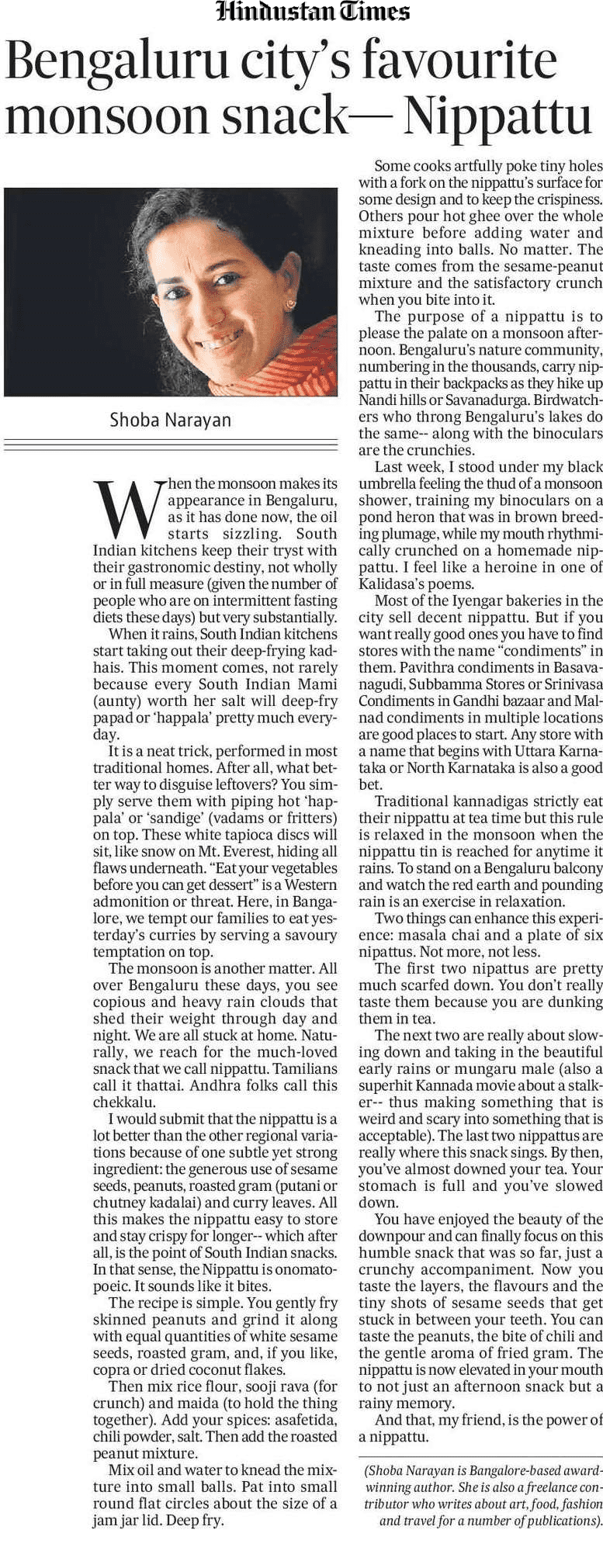About the much-loved crunchy snack that Bangaloreans reach for
When the monsoon makes its appearance in Bangalore, as it has done now, the oil starts sizzling. South Indian kitchens keep their tryst with their gastronomic destiny, not wholly or in full measure (given the number of people who are on intermittent fasting diets these days) but very substantially.
When it rains, South Indian kitchens start taking out their deep-frying kadhais. This moment comes, not rarely because every South Indian Mami (Aunty) worth her salt will deep-fry papad or ‘happala’ pretty much everyday. It is a neat trick, performed in most traditional homes. After all, what better way to disguise leftovers? You simply serve them with piping hot ‘happala’ or ‘sandige’ (vadams or fritters) on top. These white tapioca discs will sit, like snow on Mt. Everest, hiding all flaws underneath. “Eat your vegetables before you can get dessert” is a Western admonition or threat. Here, in Bangalore, we tempt our families to eat yesterday’s curries by serving a savoury temptation on top.
The monsoon is another matter. All over Bangalore these days, you see copious and heavy rain clouds that shed their weight through day and night. We are all stuck at home. Naturally, we reach for the much-loved snack that we call nippattu.

Tamilians call it thattai. Andhra folks call this chekkalu. I would submit that the nippattu is a lot better than the other regional variations because of one subtle yet strong ingredient: the generous use of sesame seeds, peanuts, roasted gram (putani or chutney kadalai) and curry leaves. All this makes the nippattu easy to store and stay crispy for longer– which after all, is the point of South Indian snacks. In that sense, the nippattu is onomatopoeic. It sounds like it bites.
The recipe is simple. You gently fry skinned peanuts and grind it along with equal quantities of white sesame seeds, roasted gram, and, if you like, copra or dried coconut flakes. Then mix rice flour, sooji rava (for crunch) and maida (to hold the thing together). Add your spices: asafetida, chili powder, salt. Then add the roasted peanut mixture. Mix oil and water to knead the mixture into small balls. Pat into small round flat circles about the size of a jam jar lid. Deep fry.
Some cooks artfully poke tiny holes with a fork on the nippattu’s surface for some design and to keep the crispiness. Others pour hot ghee over the whole mixture before adding water and kneading into balls. No matter. The taste comes from the sesame-peanut mixture and the satisfactory crunch when you bite into it.
The purpose of a nippattu is to please the palate on a monsoon afternoon. Bangalore’s nature community, numbering in the thousands, carry nippattu in their backpacks as they hike up Nandi hills or Savanadurga. Birdwatchers who throng Bangalore’s lakes do the same– along with the binoculars are the crunchies. Last week, I stood under my black umbrella feeling the thud of a monsoon shower, training my binoculars on a pond heron that was in brown breeding plumage, while my mouth rhythmically crunched on a homemade nippattu. I feel like a heroine in one of Kalidasa’s poems.
Most of the Iyengar bakeries in the city sell decent nippattu. But if you want really good ones you have to find stores with the name “condiments” in them. Pavithra condiments in Basavanagudi, Subbamma Stores or Srinivasa Condiments in Gandhi bazaar and Malnad condiments in multiple locations are good places to start. Any store with a name that begins with Uttara Karnataka or North Karnataka is also a good bet.
Traditional kannadigas strictly eat their nippattu at tea time but this rule is relaxed in the monsoon when the nippattu tin is reached for anytime it rains. To stand on a Bangalore balcony and watch the red earth and pounding rain is an exercise in relaxation. Two things can enhance this experience: masala chai and a plate of six nipattus. Not more, not less. The first two nipattus are pretty much scarfed down. You don’t really taste them because you are dunking them in tea. The next two are really about slowing down and taking in the beautiful early rains or mungaru male (also a superhit Kannada movie about a stalker– thus making something that is weird and scary into something that is acceptable). The last two nippattus are really where this snack sings. By then, you’ve almost downed your tea. Your stomach is full and you’ve slowed down. You have enjoyed the beauty of the downpour and can finally focus on this humble snack that was so far, just a crunchy accompaniment. Now you taste the layers, the flavours and the tiny shots of sesame seeds that get stuck in between your teeth. You can taste the peanuts, the bite of chili and the gentle aroma of fried gram. The nippattu is now elevated in your mouth to not just an afternoon snack but a rainy memory.
And that, my friend, is the power of a nippattu.




Leave A Comment